|
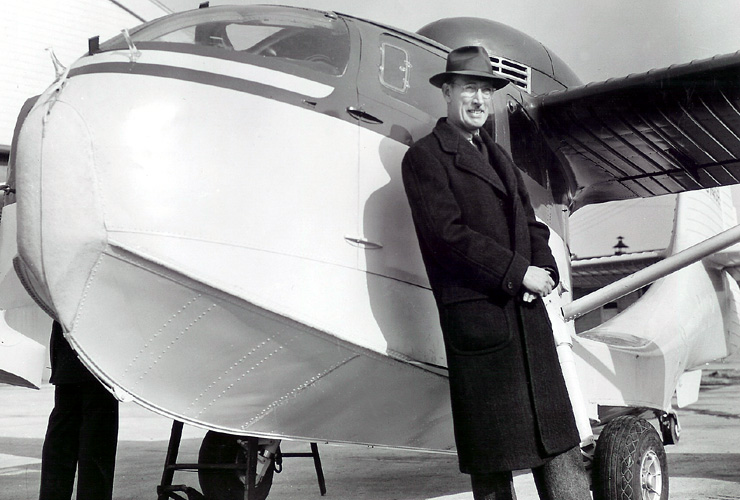
1897 - 1995
"Spence"! Reading or hearing the name "Spence",
will immediately bring any Seabee and Air Car enthusiast an image into
his head of a charismatic, slender, elderly, kind-looking gentleman -
the genius who designed some of the finest personal amphibians in the
world - the Spencer Air Car and the Republic Seabee.
Heritage
Spence's
lineage has been traced to the Crusades.
Two of his Hopkins forebears were of the 102 passengers aboard
the MAYFLOWER when they landed at Plymouth Rock in 1620, one of whom
signed the Mayflower Compact. Three
brothers in the Spencer family arrived in 1639 with grants from the King
and settled the Connecticut cities of Hartford and East Haddam.
The third settled Providence, Rhode Island.
Spence's grandfather, George Washington Rodgers, was a famous
Clipper Ship Captain and sailed the first screw propelled, steam powered
ship around the horn to San Francisco and later to Hawaii.
His daughter, Georgette, married Christopher Miner Spencer, and
from this union, Percival Hopkins Spencer was born April 30, 1897 in
Windsor, Connecticut.
Percival
Hopkins Spencer was the third child of then 63 year old inventor genius
Christopher Miner Spencer. Percival
always hated his name and preferred to be called "Spence".
Christopher
Miner Spencer (1833 - 1922) invented one of the earliest successful
repeating rifles in 1860, the automatic screw machine (that produced
screws in one operation) in 1873 and the repeating shotgun in
1886.
He had
a shooting match with President Lincoln when he demonstrated the rifle
to the President because Secretary of War, Stanton, refused to talk to a
"crackpot inventor". In
response to quizzical expressions as Spence related the incident, he
said, "Yes, it was my father, not grandfather." He then
informed the audience that his father was 63 years old when he was born.
The Spencer Repeating Rifle is credited as having shortened the
Civil War and for deciding the battle of Gettysburg.
At the
turn of the century Christopher Miner designed and built a steam
propelled yacht and several steam driven vehicles.
These were only a few highlights in the career of this inventive
genius who was born in Manchester, Connecticut. He married and lived in
Windsor, Connecticut, where he raised his young family of Roger M.,
Vesta and Percival H. Spencer.
Childhood
His
famous inventor-father would have a major influence on Spence when
growing up. In the preface to a 1983 book entitled "Spencer
Repeating Firearms", authored by Mr. Roy Martin Marcot, Spence
wrote several interesting stories about his childhood as a son of the
great inventor.
Many
of my dad's accomplishments had been made prior to my arrival on the
scene, since he was 63 years old when I was born.
This age difference had no negative effect on our relationship,
as you can see from the following incidents.
I can only wish that all children could have such a father as
mine.
As
a little boy I enjoyed weekend fishing trips with him to Long Island
Sound and the surrounding harbors in a 40-foot steam-driven,
copper-bottomed boat that he designed and built.
One evening after supper, as the boat rolled gently, he
discussed his successes, failures and exploits and showered me with
fatherly advice and encouragement.
At that age I was too young to appreciate his many inventions
and it was not until I became an adult that I became aware of the
tremendous contribution he had made to society.
No doubt the greatest was his invention of the automatic screw
machine which revolutionized mechanical industry.
It
seems such a short time ago that Dad told me of his visit to the White
House and his shooting match with Mr. Lincoln.
I remember well Mr. Lincoln's comment about a huge
horse-blanket safety pin holding the torn pocket in his coat as he
walked from the cornfield at the rear of the White House where the
target shooting took place.
I,
myself, was interested in mechanical contraptions, especially
airplanes. As I was
mechanically inclined, one can imagine that I was given full run of
his shop. He taught me
to run metal lathes, drill presses, forging equipment and all the
tools there. Not only was
I taught to operate the equipment, but I was instructed and directed
to sharpen my own lathe bits, drills and chisels.
I was given a charge account at the local hardware and lumber
stores so that I could take full advantage of the
facilities.
Dad
had built a number of steam-powered milk trucks for New York City
dairy. How excited I was
when he gave me a cast-off steam engine and boiler.
These I promptly used to build a steam-powered automobile, to
become the envy of all the kids in the neighborhood.
Vicariously he was enjoying my exploits and kept encouraging me
in the pursuit of my hobbies. His
faith in me must have been extra-ordinary, for how many fathers
encourage a ten-year-old boy to build a hang glider, then see him
graduate to a water-borne glider (to be towed behind the fishing boat
by his older brother), and finally purchase an airplane engine so that
he could make and fly an aircraft? All this occurred between
1910 - 1914.
Later
I had the pleasure of taking my dad on many flights. He had a
keen interest in aviation, and shortly before his death in 1922,
outlined the design for the world's first successful helicopter, which
he suggested as an important project for me to undertake. I had
my sights on other things and I failed to pursue this dream.
First Solo
When
Popular Mechanics Magazine published plans for a hang glider, the
youngster built one, thus providing the means to make his first solo
flight April 2, 1911 at age thirteen from Prospect Hill in Keeney Park.
Having a rather frail physique, he suffered skinned knees and
elbows and bruised his back when landing, as he could not run fast
enough with the glider slung to his shoulders.
He quickly ascertained that shifting weight to obtain control was
not the way to fly, so installed a three axis control system and made
twin pontoons from stove pipe with soldered joints reinforced by spruce
stringers. When towed behind his father's boat with 300 feet of rope and
assisted by an 8 to 10 knot wind, he was able to become airborne.
The drag of the glider was so great that it was forced to follow
the boat and could not be cut loose as it needed the help of the boat to
remain in flight.
From
the first moment I soared, it hit me that I could never be content
living on land again.
Spence
told newspaper The National Enquirer in an article published on May 12,
1987.
I've
never had a flying lesson in my life. When I first soloed in a
glider along the Connecticut River at age 13, you had to figure
everything out for yourself - and believe me. It was trial and error!,
Spence added.
Motored Flight
A
year or so later, a local man built a Curtiss type flying boat which
crashed during take off on its first flight, and was left on a sand bar
without the engine. Spence
convinced his father to purchase the wreck and proceeded to rebuild it
to flying condition. He
discovered a 4 cylinder Roberts water cooled 50 horsepower, two cycle
engine of aluminum construction on Long Island which his dad financed,
and soon thereafter the flying boat was ready for flight.
His dad must have had unlimited faith to foster flying by his 16
year old son a mere seven years after the Wright Brothers first flew in
1903.
When
completed, Spence intended to taxi the plane across the river to a nice
sand bar, but once on the river, in the exuberance of youth, he opened
the throttle a little too far and soon found himself in the air.
He felt comfortable due to his previous glider experience, but
soon realized he did not know how to turn since the glider never gave
him an opportunity to try. He
flew down the river about five miles, landed and turned around on the
water headed back home. After
getting airborne he saw the Hartford to New York night boat leaving the
dock. Taking advantage of
the opportunity, proceeded to give it a buzz job, remaining at a
"safe altitude", he said with tongue in cheek.
People on the boat probably never saw a plane in flight so waved
hysterically as he flew by. This was Spence's first flight in a powered aircraft which
was also the first flight of the aircraft.
Take off was at the foot of State Street on the Connecticut River
in Hartford, May 15, 1914, just two weeks after his 17th birthday.
That
flight was a dream, said Percival. I flew five miles - five miles down the river and made a
perfect landing on the water.
Building Airplanes
I
went through a string of planes made from souped-up boat engines and
parts from other planes - and built my first plane in 1915, when I was
17.
Shortly
after this flight, he substituted tricycle landing gear for the boat and
made several flights from Charter Oaks Race Track.
Once, as he was banking around the track, the engine "wound
down" causing the wing to make contact with the track rail pitching
Spence out to miraculously land unharmed in a pile of straw used to
protect the track from rains. As
one would suspect, the straw was liberally sprinkled with horse
droppings. When Spence crawled out of his odorous landing site, he saw
the plane balanced on the ends of the four wing spars with wings
perpendicular to the ground, and as he watched it teetering, a gentle
breeze caused it to tilt from vertical to land on its wheels.
Damage
was superficial and quickly repaired. Planes of that era usually had the engine in the rear and
pilots did not use safety belts as they figured it better to be thrown
out than remain trapped in the wreckage with the heavy engine, propeller
and possible fire.
He had
arranged to store the plane during winter in a tobacco barn across town,
and as it was now fall, he decided it was time to do it. He took off from the race track and as he flew over a large
greenhouse, the engine quit. Looking
over his shoulder, he saw the magneto dangling on the spark plug wires
because its bracket had broken. Fortunately,
he was able to glide down a slope where the kids were tobogganing to
land on a frozen pond with no damage.
After welding the bracket and re-timing the engine, he was on his
way to the tobacco barn. Here
he made an error committed by many pilots, he landed down wind.
As a result, the plane overshot the field, nosed into a wide deep
ditch, and Spence was pitched out to slide down a corn field having cut
stalks sticking up thru the snow tearing his clothes with much abrasion
to his young body. The
tangles mess was dragged into the barn and forgotten.
The
Connecticut Motor Vehicle Department issued Spence's first pilot license,
using the same certificate as used for driving license, only it said, 'Licensed
to fly airplanes'.
None
of the instructors at the Motor Vehicle Department knew how to handle
my case, since I was their first flying applicant. They finally had the instructor observe me from the ground as I
took off and landed. Not
one of them would even get in the plane with me, Spence remembered.
When
the Federal Aviation Administration was organized a few years later,
Spence was issued license number 486.
When the newspaper article was written in 1987, Spence was still
flying at 90, having the lowest license number of any living person
flying then.
|
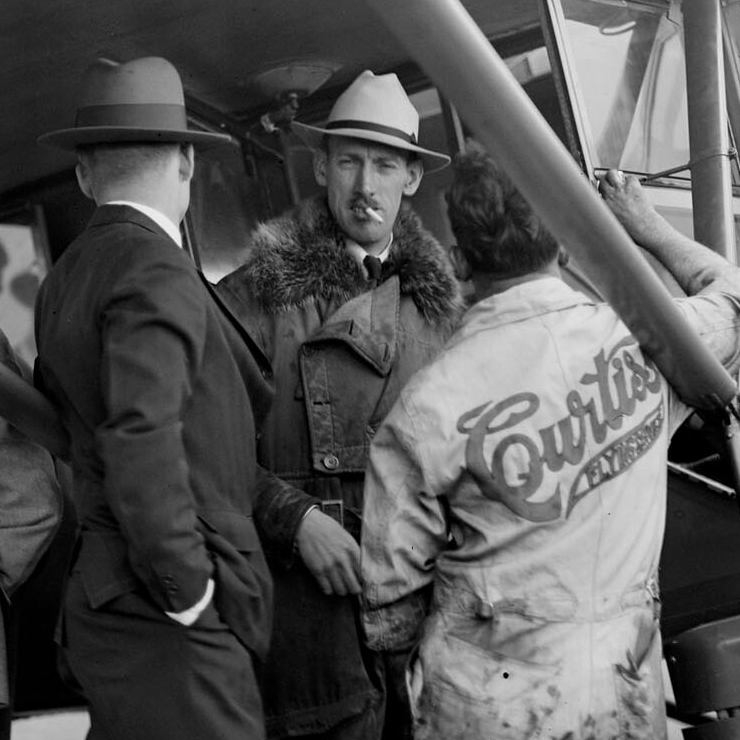
Lt. Percivial H. Spencer
World Altitude Record
02 June 1929
Photo: © Leslie Jones / Boston Public Library
Into The Aviation Industry
During
1915-1916, he used a Roberts 6 cylinder 100 horsepower engine to
construct a single pontoon biplane, which was damaged as he attempted to
taxi it from a lagoon into the river.
He decided to replace the pontoon with wheels and began flying
from a field just north of the Hartford.
A bad landing destroyed the plane and trapped Spence in the
wreckage. The hot water
from the engine caused severe burns until bystanders extricated him.
Later in 1916, he worked for Lowe, Willard & Fowler
Engineering Corporation who built planes primarily for the Navy.
In
1917, due to his experience as a pilot and builder, he was sent to the
B. F. Sturdevant Co. in Boston as an inspector of Curtiss Jenny
fuselages on assignment as an employee of the Bureau of Aircraft
Production, U.S. Army Signal Corps.
After WW I, Spence built a three passenger, single float seaplane,
with wing tip floats. The
airplane was powered with a Curtiss OX6 engine.
Fish glue used in the construction produced a strong, offensive
odor causing it to be named "Old Rotten Belly".
He and his school friend, Stewart Chadwick, were successful
barnstorming with it in the New England area.
In addition, he modified a Thomas Morse Scout by clipping the
lower wing and substituting an OX5 cowled engine for its original
LeRhone to win a number (5) of races, reaching speeds up to 127 mph.
From
1922 to 1925, Spence became the first manager of the Hartford Airport where
he owned five Avro 504 biplanes used for training, passenger rides and
charters. In 1925, he
formed and was president of the New England Aircraft Corporation, in
Hartford, CT., which was recognized as New England's largest aero sales
and service organization, and was the first to obtain a WACO airplane
franchise, starting with the famous WACO Nine.
In 1925 Spence also designed the S-10, a low-wing landplane,
which proceeded to blow up in the air.
A friend, Bert Lott, who was flying it, ducked the shower of
valves and pistons and yelled down to Spence: Hey, it's all over now!
Lott managed to land, and for a while Spence gave up designing.
He sold
his corporation to the Curtiss Flying Service, Boston, in 1929 to remain
with them as sales manager and Chief Demonstration Pilot of their New
England Division. That year
he established a world altitude record for light aircraft when flying an
OX5 powered Curtiss Robin B to an altitude of 18 671 ft.
Spence also competed in the 1929 National Air Races at Cleveland,
Ohio.
From
1930 to 1934, he became Sales Representative and Chief Test Pilot for
Ireland Aircraft Corporation, leading producers of two to five passenger
amphibians. He remained
with the corporation when it was purchased by Amphibians Inc.
Beginning
in 1934, he flew a Ford Tri-motor for Shell Eastern Petroleum Corporation
for a year, and then went to Sikorsky Aircraft Manufacturing Co.
where he worked on construction and inspection of their S-43
flying boat. Soon he was
offered the position of Executive Pilot for the president of Pan
American Airways, Mr. Juan Trippe, a position which he filled until mid
1937, flying a Fairchild 91 amphibian.
|
|
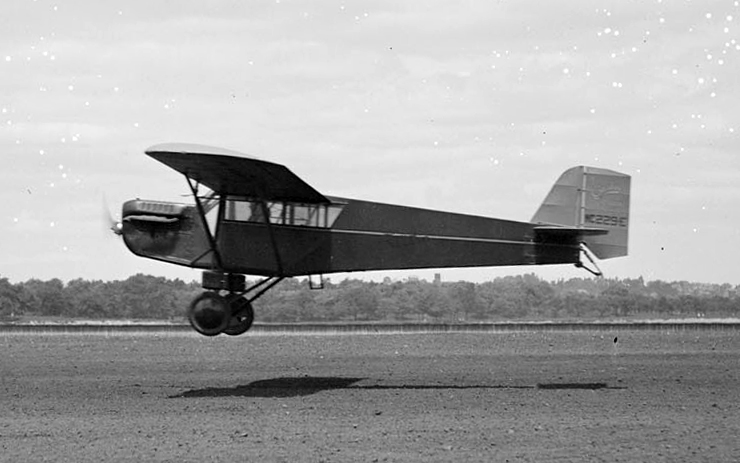
NC229E Curtiss Robin B (s/n 101)
World Altitude Record
East Boston Airport
02 June 1929
Photo: © Leslie Jones / Boston Public Library
Spencer
Larsen Amphibian
The
desire to produce a superior amphibian led him to organize, in January 1937, the
Spencer-Larsen Aircraft Corporation, together with Victor Larsen and a
total of about 15 major stockholders investing to the extent of $ 35,000
in the company. The company
started operation in a factory in Farmingdale, Long Island. Spencer
became the president of company, and Larsen the vice president and chief
engineer. They developed the SL-12C amphibian largely based on
Larsen's design ideas, Spencer's contribution limited to the idea of
putting the landing wheels in the stern position of retractable wing
floats. They conceived a unique design by burying the
125 hp Menasco engine engine inside the
hull, with the pusher propeller remotely driven by a geared extension shaft from the
engine. The SL-12C amphibian was
completed in May 1938 and test flights were begun from the water at Port
Washington, Long Island, in June, piloted by P. H. Spencer.
Initial trials disclosed many inherent problems, such as violent
vibration of the propeller drive strut; the hull operation on water due
to step location and form; the aerodynamic characteristics of the wing
due to premature violent tip stall condition; inadequate engine cooling;
and the lack of lateral buoyancy of wing floats to prevent the wing tip
from dragging in the water und under light cross wind taxi conditions.
|
|
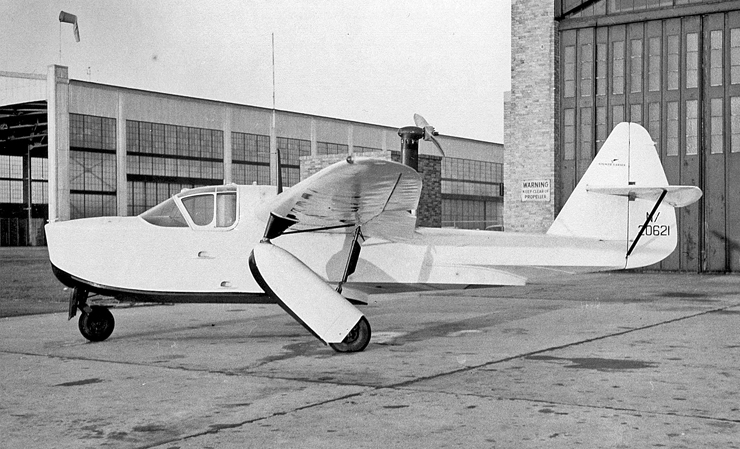
Spencer-Larsen
SL-12C
Photo courtesy of Dan Shumaker
Some
of the above problems were corrected and about ten hours of flying were
accomplished ina all, before the plane was dismantled. It was evident
form the many difficulties that the amphibian would have to be
redesigned completely, largely because of incorporating in the the
original design so many radical features. One of the major
shareholders in the company, Richard du Pont, decided not to
invest further funds in the project, and Spencer agreed with him. The
company was reorganized and became the Colgate-Larsen Company.
Even Mr. Larsen left the company about a year after the reorganization
and the company became the Colgate Aircraft Corporation.
Spencer
resigned in August 1940, prior to the reorganization and started detail
design of the "Spencer Amphibian Air Car", his
own concept of an ideal amphibian, which was in
model form before Spencer met Victor Larsen. By 1941, he had designed, built and flown his Spencer Amphibian
Air Car #1, but was forced to put it in storage due to WW II
restrictions to civilian flying.
|
|
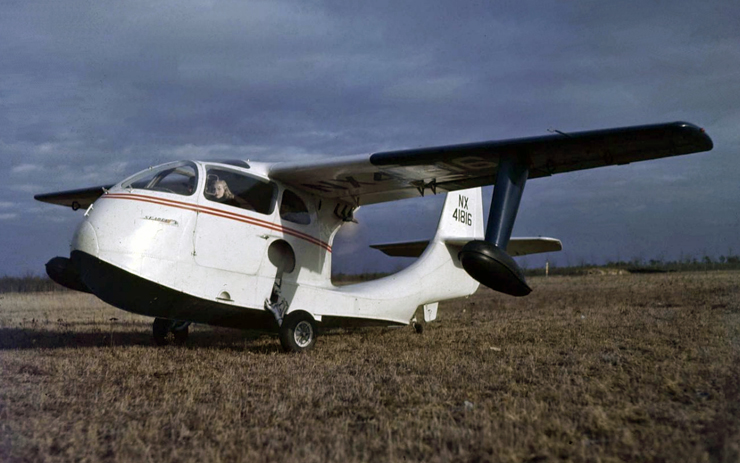
Republic
RC-1 Thunderbolt Amphibian
Photo: Ruby Arnold RAC/NASM
Spencer
Air Car Amphibian
The
desire to produce a superior amphibian led him to organize, in January 1937, the
Spencer-Larsen Aircraft Corporation, together with Victor Larsen and a
total of about 15 major stockholders investing to the extent of $ 35,000
in the company. The company
started operation in a factory in Farmingdale, Long Island. Spencer
became the president of company, and Larsen the vice president and chief
engineer. They developed the SL-12C amphibian largely based on
Larsen's design ideas, Spencer's contribution limited to the idea of
putting the landing wheels in the stern position of retractable wing
floats. They conceived a unique design by burying the
125 hp Menasco engine engine inside the
hull, with the pusher propeller remotely driven by a geared extension shaft from the
engine. The SL-12C amphibian was
completed in May 1938 and test flights were begun from the water at Port
Washington, Long Island, in June, piloted by P. H. Spencer.
Initial trials disclosed many inherent problems, such as violent
vibration of the propeller drive strut; the hull operation on water due
to step location and form; the aerodynamic characteristics of the wing
due to premature violent tip stall condition; inadequate engine cooling;
and the lack of lateral buoyancy of wing floats to prevent the wing tip
from dragging in the water und under light cross wind taxi conditions.
Some
of the above problems were corrected and about ten hours of flying were
accomplished ina all, before the plane was dismantled. It was evident
form the many difficulties that the amphibian would have to be
redesigned completely, largely because of incorporating in the the
original design so many radical features. One of the major
shareholders in the company, Richard du Pont, decided not to
invest further funds in the project, and Spencer agreed with him. The
company was reorganized and became the Colgate-Larsen Company.
Even Mr. Larsen left the company about a year after the reorganization
and the company became the Colgate Aircraft Corporation.
Spencer
resigned in August 1940, prior to the reorganization and started detail
design of the "Spencer Amphibian Air Car", his
own concept of an ideal amphibian, which was in
model form before Spencer met Victor Larsen. By 1941, he had designed, built and flown his Spencer Amphibian
Air Car #1, but was forced to put it in storage due to WW II
restrictions to civilian flying.
Immediately,
he began to work on his concept of an ideal amphibian.
By 1941, he had designed, built and flown his Spencer Amphibian
Air Car #1, but was forced to put it in storage due to WW II
restrictions to civilian flying.
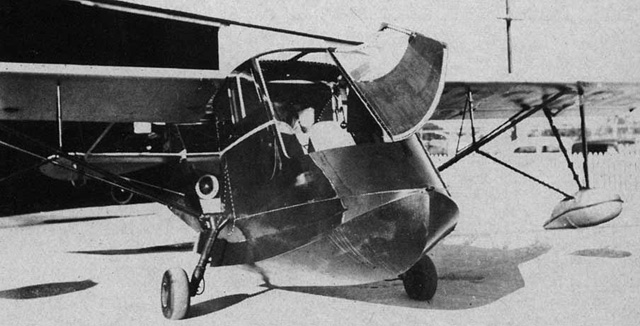
The
first Spencer S-12 Amphibian Air Car 1941
Later
in 1943, it with its design patent was sold to and produced by Republic
Aviation Corporation as the "Seabee." As test pilot for
Republic Aircraft Corp. from
1941 to 1943, he made the first flight of 286 P-43 and P-47 fighter
aircraft as they rolled off the production line, experiencing one
miraculous escape from sure death when a gear in the propeller broke
just as the wheels left the runway on takeoff. He and the plane
survived because of superior pilotage, for which he was commended.

When
Republic decided to start production of a variant of his Spencer
Amphibian Air Car #1, Spence became Design Consultant, Test and
Demonstration Pilot for the Republic Seabee from 1943 to 1945.
Spence personally made the first
flight for both the experimental RC-1 Thunderbolt Amphibian and the
production model RC-3 Seabee, on 30 November 1944 and 01 December 1945
respectively. First deliveries of production model were made in
June 1946 and a total of 1060 RC-3 Seabees were built when production
ended in October 1947. Spence
received a royalty for each Seabee produced.
|
|
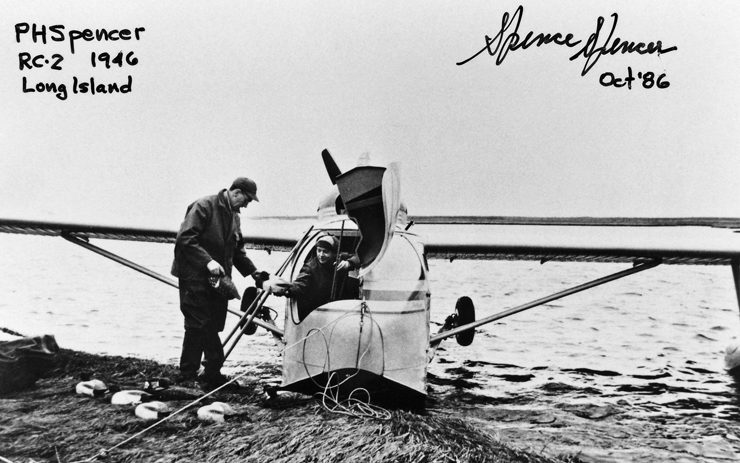
Republic RC-3
Seabee (Spence signed photo)
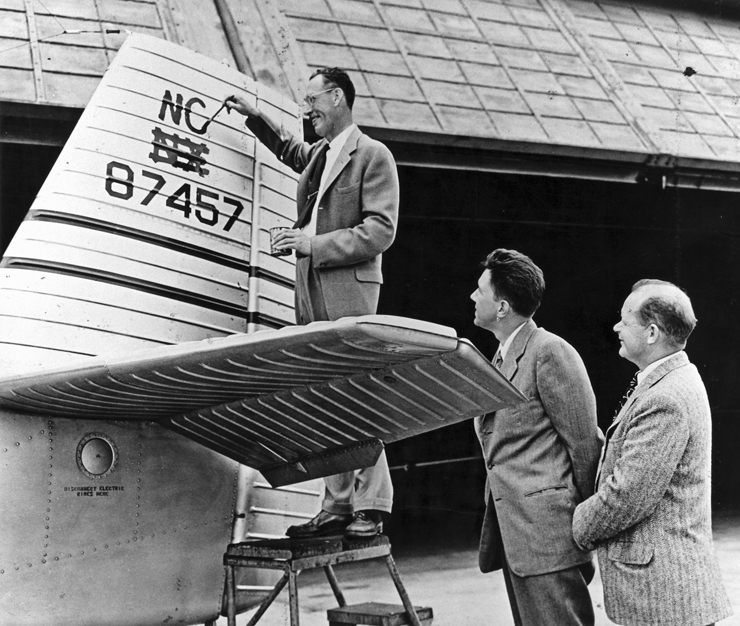
P. H. Spencer, designer of
Republic's Seabee,
smilingly paints the coveted 'NC' on the tail of
Seabee NC87457 (ex NX87457)
to celebrate the CAA certification of the
Seabee.
21 July 1946
Ornithopters
From 1945 to 1953, he became semi-retired with
activity in real estate development and home construction in Florida.
1954 to 1957 he came back to aviation industry as
Staff Assistant for Lear Aircraft, Santa Monica, CA, for the Lear Star
Aircraft Production.
1955 found him back at the drafting board to design
and promote his S-12B single engine amphibian and during 1956-1957,
designing and promoting his S-13 twin engine amphibian which used either
piston or Allison turbo-prop engines.
As a youngster, Spence, with three feathers from his
pigeon loft, he made a successful ornithopter and used this expertise
later in life to market a rubber propelled model which in 1958 was
adjudged one of the ten best toys of the year. Further development resulted in a motor powered version, one of
which is on display in the Smithsonian Air and Space museum as a World's
First.
In 1958 he sold patent license rights on his rubber
powered ornithopter to The Wham-O Manufacturing Company, that produced
650,000 units. He also developed the production tooling for the company and
remained as consultant until 1960. This was rated as one of the
ten best toys of the year by an article in Life Magazine.
During 1961-1964, Spence developed the first
successful gasoline engine powered ornithopter, in the likeness of a
seagull. The prototype is on display in the Smithsonian
Institution Air & Space Museum as a world's first. He
continued the project to design in detail a full scale man carrying
version, which was evaluated by teams from Princeton University and
Hughes Aircraft Corp., who agreed it would meet performance
specification if built according to plans. A radio controlled
model is on display in the New England Air Museum in Windsor Locks, CT.
|
|
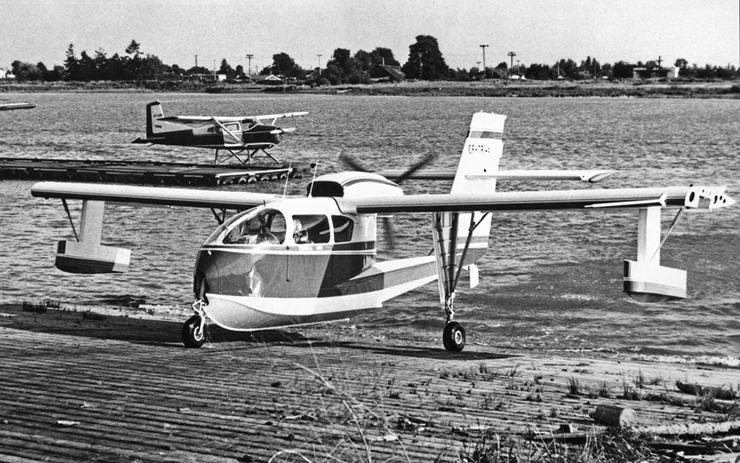
Trident
TR-1 Trigull Amphibian
Photo: Ken Molson
Trident Trigull Amphibian
In 1965 Spence
established Trident Aircraft Corporation in
collaboration with Chuck Y. Herbst, and as a team designed
the Trident Amphibian. The design was sold on to Trident Aircraft Company,
Vancouver, B.C., Canada. The name of
this aircraft of outstanding performance was changed to Trident TR-1 Trigull by the
new owners. Two prototypes were built and the aircraft was certified and
awarded a Type Approval. However, the due to lack of funding and
government support, the Trigull never entered production. All rights for
the Trigull design are now owned Viking Air, the makers of the DHC-6
Twin Otter Series 400. Currently there are no plans for putting
the Trigull into production.
|
|

Spencer
S-12D Air Car Homebuilt Amphibian
N111DA Protoype
Homebuilt Air Car Amphibians
In 1968, Spence designed and marketed with his partner,
retired USAF Col. Dale L. "Andy" Anderson, the 4 passenger
Spencer Amphibian Air Car, (S-12C, D, E) as home built kits.
First flight of one hour was made at Chino Airport,
California, on May 25, 1970, and initial water tests were made at Lake
Havasu on the Colorado River, July 8, 1970. Late in July, the Air Car was ready for the trip to the
EAA. Fly-in at Oshkosh, Wis. However,
Spence and Andy were weathered in along with others, for five days at
Kansas City and missed their opportunity to demonstrate the Air Car.
They continued the tour Eastward as originally
planned and made a 5,000 mile circuit via Pittsburg, Mobile, New Orleans,
Houston, El Paso, Tucson and Los Angeles. Andy and Spence built the Air Car in a two-car garage with the
usual hobby shop tools with the exception of certain parts of the
landing gear, which required machine shop equipment. It was completed in 18 1/2 months and flown two weeks later.
The cost of construction was $4700.00 less engine,
propeller, instruments and radio. Completed
cost was $8700.00 powered with a low time 180 HP O-360 Lycoming engine,
constant speed Hartzell propeller and full group instrument panel with
used Bendix 220-Nav/Com. Many
pilots flew the Air Car and spoke highly of its fine handling qualities,
especially in the water.
The
prototype was soon stressed for 3100 lbs gross
weight (Standard category) and 260 HP engine. This provided high lake operation capability with 1050 lbs of
useful load.
|
|
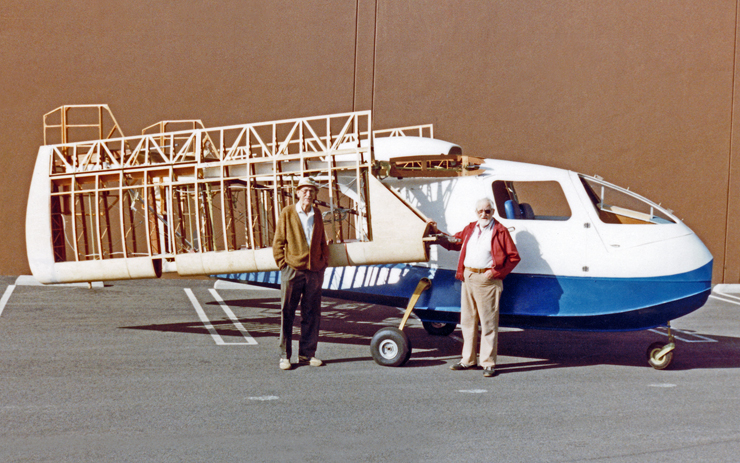
Spence
and Andy in front of the S-14 Air Car Jr.
In 1980, he began design of the S-14, a two-place Air
Car Junior amphibian of advanced composite construction with folding
wings for highway transport. Spence
was pilot on the first flight of this plane November 4, 1983 at age 86
years, 7 months, as well as being pilot on all subsequent flights
totaling 37.5 hours.
The design prototype did not meet the
expectations, and after some modifications, the project was terminated
in 1984. Spence lost eighty-five thousand dollars on the
project. His long time and good friend, William Randolph Hearst
Jr. came to his rescue by purchasing the Air Car Junior prototype for
the salvage price of twenty-five thousand dollars, and then donating it
to the Experimental Aircraft Association Museum in Oshkosh, Wisconsin,
in September 1984.
After ending the Air Car Jr. project,
Spence and Andy, put their efforts back into the good old S-12D/E Air
Car homebuilt, selling several plans after a number of magazine
articles. In 1991 Spence and Andy sold the Air Car design to Mr. Kerans.
|
|

P. H. Spencer
holding a part for the Spencer S-14 Air Car Jr. homebuilt amphibian.
Photo: Courtesy of P. H. Spencer
Spence's Last Years
In
a
1987 "The National Enquirer" newspaper article, Spence said;
Every
January, I take my flight examination. When you're as old as I am, they monitor your heart rate and
put you on a treadmill. They
want to make sure I won't kick-off while I'm up in the sky. But I always pass with flying colors.
I'd
tell any young boy or girl, if they want to make flying a career, to
go to a good flight school or join the Air Force. But be careful.
Once
you start flying you may never stop - even when you're as old as me.
On July
28th, 1987, Spence donated all his memorabilia and awards to the New
England Air Museum, at Bradley Field, CT.
In July 1989 Spence spoke to about 150 relatives who came accross
the country to the New England Air Museum for a family reunion.
When
Spence retired from flying in February 1988, with more than 6500 hours
in his logs, he had been flying longer than any other person, and was
believed to be the oldest licensed pilot in the United States.
The Early Birds of Aviation is an exclusive group who flew solo
before December 17, 1916. Of
the 598 original Early Birds, Spence was one of the four remaining members.
Spence
passed away quietly in his sleep early morning January 16, 1995 in the
Del Amo Nursing Home, Torrance, California.
Interment of his ashes is in the family plot, Windsor,
Connecticut. Reverend
Patrick J. McPolin, a Life Member EB and long time, dear friend,
eulogized Spence in a memorial service at Domingues Chapel, Rancho
Domingues, CA., February 10, 1995. This was most appropriate since the Domingues Ranch Adobe,
now the Domingues Seminary, was the site of the first air meet in the
USA in 1910.
Father
Pat, with the chapel reflecting an aviation atmosphere, programmed an
outstanding service. He had
arranged a large easel draped in black holding a helmet and goggles and
photo portrait of Spence taken about 15 years ago, just as his friends
wished to remember him. The
base of the easel was blanketed with beautiful floral tributes.
Father Pat maintained the aviation theme as he officiated wearing
a black leather flight jacket in lieu of his clerical robes.
Following the service, there was a flyby with one of Spence's
famous designs, a Seabee, in the lead.
Those attending the funeral wished that all Spence's friends
could have been present at this most memorable occasion.
Twelve
years before, Spence attended a commemoration service for a pilot friend
at Whiteman Airpark restaurant and stated he would like to have one when
his time came, but believed a hangar would be a more appropriate place
for fly-boys. He discussed
this with a friend who had a large hangar, and he quickly agreed to
offer his for the occasion.
|
|
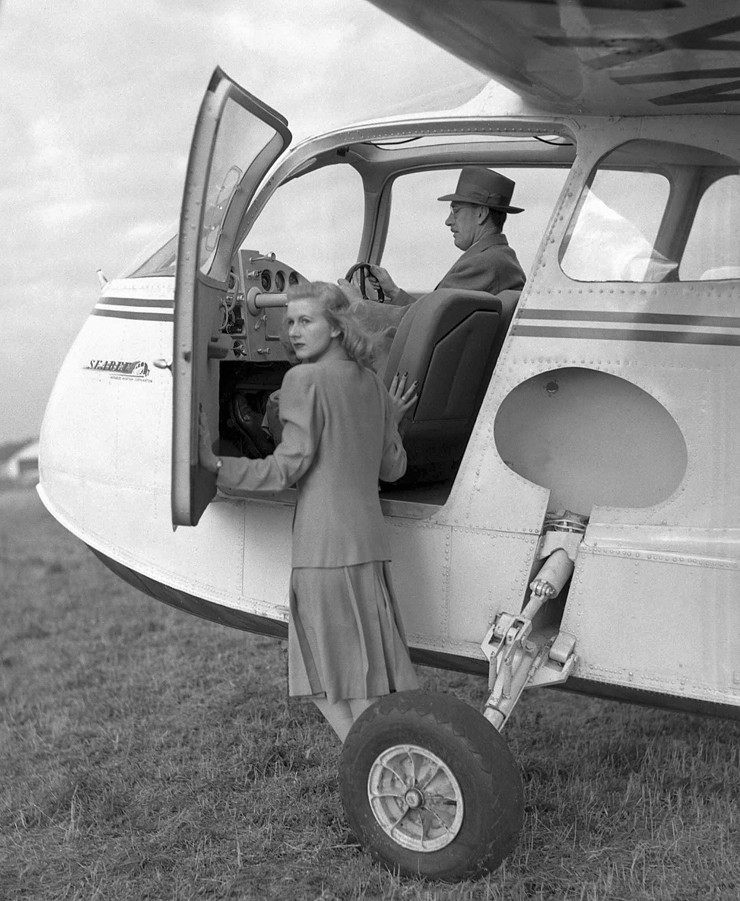
|













